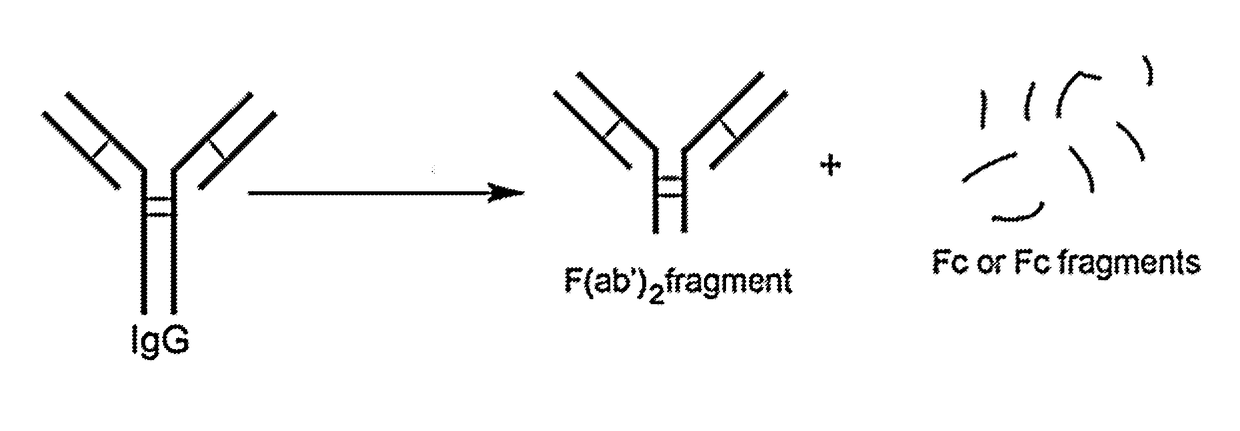Near infrared photoimmunotherapy (nir-pit) of suppressor cells to treat cancer
- Summary
- Abstract
- Description
- Claims
- Application Information
AI Technical Summary
Benefits of technology
Problems solved by technology
Method used
Image
Examples
example 1
Materials and Methods
Reagents
[0221]Water soluble, silicon-phthalocyanine derivative IRDye 700DX NHS ester was from LI-COR Bioscience (Lincoln, Nebr.). Anti-mouse CD25 antibody (PC-61.5.3) and Rat-IgG1 (HRPN) were from BioXCell (West Lebanon, N.H.). All other chemicals were of reagent grade.
Cell Culture
[0222]Luciferase expressing MC38 (mouse colon cancer), LL / 2 (Lewis lung carcinoma), and TRAMP-C2 (prostate cancer) mouse cell lines (ATCC, Manassas, Va. MC38-luc, LL / 2-luc, and TRAMP-C2-luc respectively) were established by transducing RediFect Red-FLuc lentiviral particles (PerkinElmer, Waltham, Mass.). High luciferase expression was confirmed with 10 passages. IL-2 dependent CD25-expressing mouse T lymphocyte HT-2 clone A5E cells (HT-2-A5E) were from ATCC. Cells were cultured in RPMI 1640 medium (Thermo Fisher Scientific Inc., Rockford, Ill.) supplemented with 10% fetal bovine serum and 100 IU / mL penicillin / 100 μg / mL streptomycin (Thermo Fisher Scientific Inc.). For HT-2-A5E cell cul...
example 2
Preparation of Anti-CD25-F(Ab′)2-IR700
[0237]A F(ab′)2 fragment of the anti-mouse CD25 antibody (anti-CD25-F(ab′)2) or Rat-IgG1 as a control, was generated as shown in FIG. 1. The resulting F(ab′)2 fragments do not have an Fc portion, and thus will not generate a significant ADCC response in vivo.
[0238]The resulting anti-CD25-F(ab′)2 antibody fragments were conjugated to IR700 as described in Example 1. The resulting conjugate (anti-CD25-F(ab′)2-IR700), having about three IR700 molecules per single F(ab′)2, was used in the experiments described below.
example 3
In Vitro Characterization of Anti-CD25-F(Ab′)2-IR700
[0239]To avoid Fc-mediated antibody-dependent-cellular-cytotoxicity (ADCC) and complement-dependent-cytotoxicity (CDC) in vivo, F(ab′)2 were generated from an anti-CD25 antibody (anti-CD25-F(ab′)2) and a control IgG antibody (control-F(ab′)2). Both F(ab′)2 were purified using a high performance liquid chromatography (HPLC) with over 90% purity (about 97%) and conjugated with the IR700 dye (anti-CD25-F(ab′)2-IR700 and control-F(ab′)2-IR700, respectively) (FIGS. 2A and 2B). The anti-CD25-F(ab′)2-IR700 demonstrated specific binding to CD25 expressed on a mouse T lymphocyte HT-2 clone A5E (HT-2-A5E) cells (FIG. 2C). These results indicated that the bioactivity and specificity of anti-CD25-F(ab′)2 was maintained during digestion, purification and conjugation.
[0240]The absence of a systemic ADCC or CDC effect was confirmed by administering anti-CD25-F(ab′)2 (100 μg) to mice and analyzing the splenic CD4+CD25+Foxp3+Tregs 1 day later. Whil...
PUM
| Property | Measurement | Unit |
|---|---|---|
| Fraction | aaaaa | aaaaa |
| Size | aaaaa | aaaaa |
| Nanoscale particle size | aaaaa | aaaaa |
Abstract
Description
Claims
Application Information
 Login to View More
Login to View More - R&D
- Intellectual Property
- Life Sciences
- Materials
- Tech Scout
- Unparalleled Data Quality
- Higher Quality Content
- 60% Fewer Hallucinations
Browse by: Latest US Patents, China's latest patents, Technical Efficacy Thesaurus, Application Domain, Technology Topic, Popular Technical Reports.
© 2025 PatSnap. All rights reserved.Legal|Privacy policy|Modern Slavery Act Transparency Statement|Sitemap|About US| Contact US: help@patsnap.com



